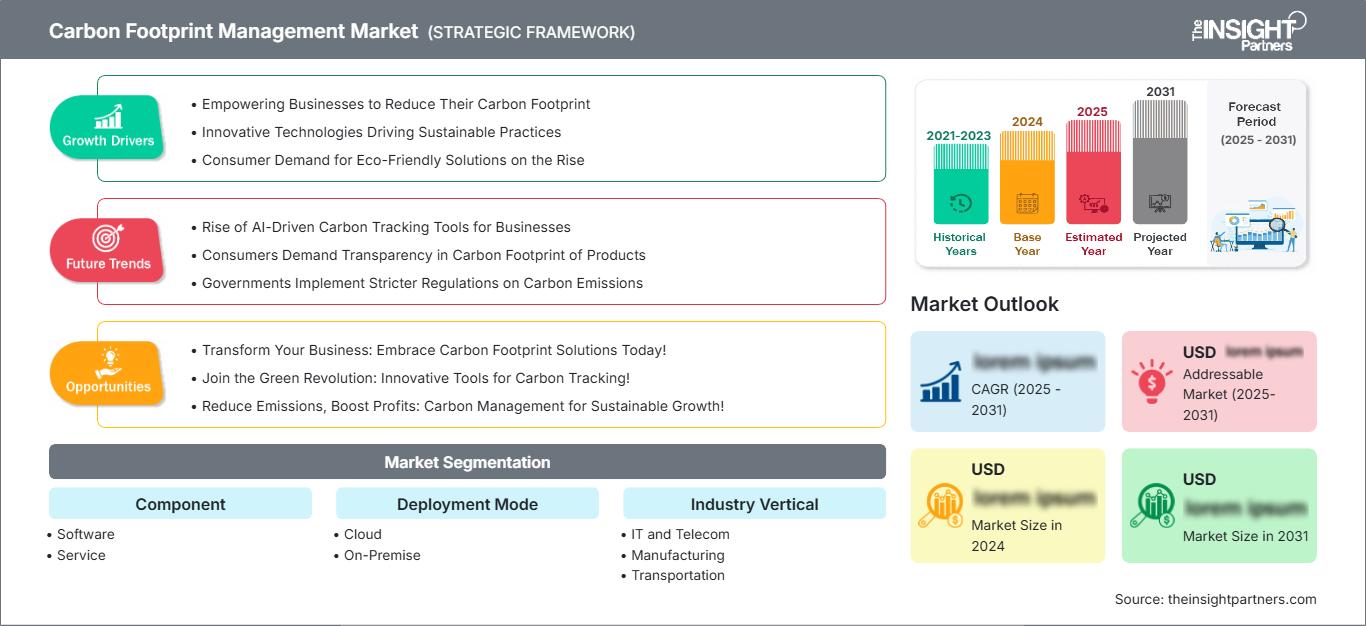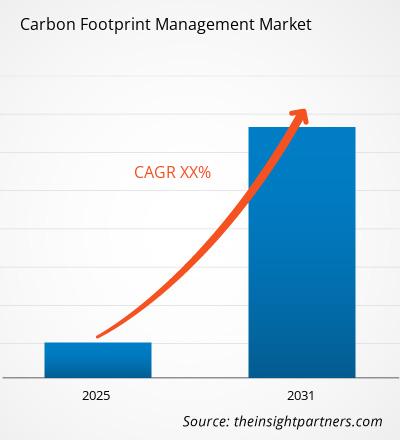カーボンフットプリント管理市場は、2025年から2031年にかけてXX%のCAGRで成長し、市場規模は2024年のXX百万米ドルから2031年にはXX百万米ドルに拡大すると予想されています。
本レポートは、コンポーネント(ソフトウェア、サービス)別に分類され、導入モード(クラウド、オンプレミス)に基づいて市場をさらに分析しています。また、業種別(IT・通信、製造、運輸、商業ビル、公共事業)についても市場を分析しています。これらの主要セグメントごとに、世界、地域、国レベルで包括的な内訳が提供されています。本レポートには、全セグメントの市場規模と予測が含まれており、値は米ドルで表示されています。また、主要プレーヤーの現在の市場状況に関する重要な統計情報とともに、一般的な市場トレンドと新たな機会に関する洞察も提供します。
レポートの目的
The Insight Partners によるレポート「Carbon Footprint Management Market」は、現在の状況と将来の成長、主な推進要因、課題、機会について説明することを目的としています。これにより、次のようなさまざまなビジネス関係者に洞察が提供されます。
- 技術プロバイダー/メーカー: 進化する市場ダイナミクスを理解し、潜在的な成長機会を把握することで、情報に基づいた戦略的決定を下すことができます。
- 投資家: 市場の成長率、市場の財務予測、バリュー チェーン全体に存在する機会に関する包括的なトレンド分析を実施します。
- 規制機関: 市場の乱用を最小限に抑え、投資家の信頼と信用を維持し、市場の完全性と安定性を維持することを目的として、市場における政策と警察活動を規制します。
カーボンフットプリント管理市場セグメンテーションコンポーネント
- ソフトウェア
- サービス
導入モード
- クラウド
- オンプレミス
業種
- ITおよび通信
- 製造業
- 運輸業
- 商業ビル
- 公益事業
レポートの一部、国レベルの分析、Excelデータパックなどを含め、スタートアップ&大学向けに特別オファーや割引もご利用いただけます(無償)
カーボンフットプリント管理市場: 戦略的洞察

- このレポートの主要な市場動向を入手してください。この無料サンプルには、市場動向から見積もりや予測に至るまでのデータ分析が含まれます。
カーボンフットプリント管理市場の成長要因
- 企業のカーボンフットプリント削減を支援
- 革新的な技術による持続可能な慣行の推進
- 環境に優しいソリューションに対する消費者の需要の高まり
カーボンフットプリント管理市場の将来の動向
- 企業向けAI駆動型カーボン追跡ツールの台頭
- 消費者は製品のカーボンフットプリントの透明性を要求
- 政府は炭素排出に関するより厳しい規制を実施
カーボンフットプリント管理市場の機会
- ビジネスを変革:今すぐカーボンフットプリントソリューションを導入
- グリーン革命に参加:革新的なカーボン追跡ツール
- 排出量を削減し、利益を増やす:持続可能なカーボン管理成長
カーボンフットプリント管理市場
予測期間を通じてカーボンフットプリント管理市場に影響を与える地域的な傾向と要因については、The Insight Partnersのアナリストが詳細に説明しています。このセクションでは、北米、ヨーロッパ、アジア太平洋、中東・アフリカ、中南米におけるカーボンフットプリント管理市場のセグメントと地域についても説明します。
カーボンフットプリント管理市場レポートの範囲
| レポート属性 | 詳細 |
|---|---|
| の市場規模 2024 | US$ XX Million |
| 市場規模別 2031 | US$ XX Million |
| 世界的なCAGR (2025 - 2031) | XX% |
| 過去データ | 2021-2023 |
| 予測期間 | 2025-2031 |
| 対象セグメント |
By コンポーネント
|
| 対象地域と国 | 北米
|
| 市場リーダーと主要企業の概要 |
|
カーボンフットプリント管理市場のプレーヤー密度:ビジネスダイナミクスへの影響を理解する
カーボンフットプリント管理市場は、消費者の嗜好の変化、技術の進歩、製品の利点に対する認知度の高まりといった要因によるエンドユーザーの需要増加に牽引され、急速に成長しています。需要の増加に伴い、企業は提供内容を拡大し、消費者ニーズを満たすための革新を進め、新たなトレンドを活用しており、これが市場の成長をさらに促進しています。

- 入手 カーボンフットプリント管理市場 主要プレーヤーの概要
主なセールスポイント
- 包括的な調査範囲:本レポートは、カーボンフットプリント管理市場の製品、サービス、タイプ、エンドユーザーの分析を包括的に網羅し、包括的な展望を提供しています。
- 専門家による分析:本レポートは、業界の専門家とアナリストの深い理解に基づいて作成されています。
- 最新情報:本レポートは、最新の情報とデータ動向を網羅しているため、ビジネスの関連性を保証します。
- カスタマイズオプション:本レポートは、特定のクライアントの要件に対応し、ビジネス戦略に適切に適合するようにカスタマイズできます。
したがって、カーボンフットプリント管理市場に関する調査レポートは、業界のシナリオと成長の見通しを解読し理解するための先導役となります。いくつかの正当な懸念事項があるかもしれませんが、本レポートの全体的なメリットは、デメリットを上回る傾向があります。
- 過去2年間の分析、基準年、CAGRによる予測(7年間)
- PEST分析とSWOT分析
- 市場規模価値/数量 - 世界、地域、国
- 業界と競争環境
- Excel データセット
最新レポート
関連レポート
お客様の声
購入理由
- 情報に基づいた意思決定
- 市場動向の理解
- 競合分析
- 顧客インサイト
- 市場予測
- リスク軽減
- 戦略計画
- 投資の正当性
- 新興市場の特定
- マーケティング戦略の強化
- 業務効率の向上
- 規制動向への対応




















 無料サンプルを入手 - カーボンフットプリント管理市場
無料サンプルを入手 - カーボンフットプリント管理市場